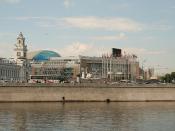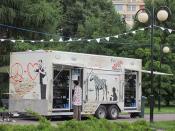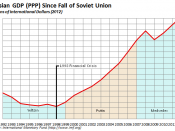Introduction Top of Page Background: The defeat of the Russian Empire in World War I led to the seizure of power by the communists and the formation of the USSR. The brutal rule of Josef STALIN (1924-53) strengthened Russian dominance of the Soviet Union at a cost of tens of millions of lives. The Soviet economy and society stagnated in the following decades until General Secretary Mikhail GORBACHEV (1985-91) introduced glasnost (openness) and perestroika (restructuring) in an attempt to modernize communism, but his initiatives inadvertently released forces that by December 1991 splintered the USSR into 15 independent republics. Since then, Russia has struggled in its efforts to build a democratic political system and market economy to replace the strict social, political, and economic controls of the communist period. Russia Geography Top of Page Location: Northern Asia (that part west of the Urals is sometimes included with Europe), bordering the Arctic Ocean, between Europe and the North Pacific Ocean Geographic coordinates: 60 00 N, 100 00 E Map references: Asia Area: total: 17,075,200 sq km land: 16,995,800 sq km water: 79,400 sq km Area - comparative: slightly less than 1.8
times the size of the US Land boundaries: total: 19,961 km border countries: Azerbaijan 284 km, Belarus 959 km, China (southeast) 3,605 km, China (south) 40 km, Estonia 294 km, Finland 1,313 km, Georgia 723 km, Kazakhstan 6,846 km, North Korea 19 km, Latvia 217 km, Lithuania (Kaliningrad Oblast) 227 km, Mongolia 3,485 km, Norway 167 km, Poland (Kaliningrad Oblast) 206 km, Ukraine 1,576 km Coastline: 37,653 km Maritime claims: continental shelf: 200-m depth or to the depth of exploitation exclusive economic zone: 200 NM territorial sea: 12 NM Climate: ranges from steppes in the south through humid continental in much of European Russia; subarctic in Siberia to tundra climate in...


